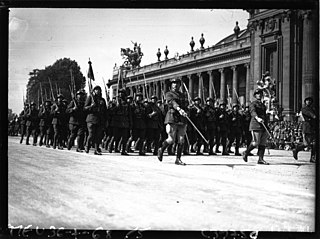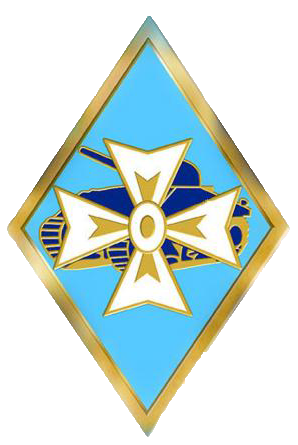This article needs additional citations for verification .(January 2009) |
The 68th Infantry Division (French : 68e Division d'Infanterie, 68e DI) was a French Army formation during the First and Second World Wars.
This article needs additional citations for verification .(January 2009) |
The 68th Infantry Division (French : 68e Division d'Infanterie, 68e DI) was a French Army formation during the First and Second World Wars.
During the war of 1914 to 1918, the division comprised:
It was part of the French 2nd, 3rd, 7th, 11th, 13th, 14th, 15th, 16th, 17th, 20th, 21st, 35th, 39th and 40th Corps, during which it participated in the Battle of Morhange, the Battle of Grand Couronne, the Battle of Verdun, the Second Battle of the Marne, and the Meuse-Argonne Offensive.
At various times, the Division was part of the First, Second, Third, Fourth, Fifth, Sixth, Seventh, Eighth, and Tenth French Armies. [1]
During the Battle of France in May 1940, the division contained the following units:
It was a "Series B" Reserve division, containing older reservists. The division was used to defend the coast of northern France.

The 55th Infantry Division was a French Army formation during World War I and World War II.
The 71st Infantry Division was a French Army formation during both World War I and World War II.
The 41st Infantry Division was a French Army formation during World War I and World War II.
The 21st Infantry Division was a French Army formation during World War I and World War II.
The 60th Infantry Division was a French Army formation during World War I and World War II.
The 53rd Infantry Division was a French Army formation during World War I and World War II.
The 61st Infantry Division was a French Army formation during World War I and World War II
The French 102nd Division was an Infantry division of the French Army during World War I, and a Fortress division during World War II.
The 32nd Infantry Division was a French Army formation during World War I and World War II.

The 8th Infantry Division was a French Army formation during World War I, World War II and the Cold War. It was dissolved in 1993.
The 18th Infantry Division was a French Army formation during World War I and World War II.
The 22nd Infantry Division was a French Army formation during World War I and World War II.

The 3rd Colonial Infantry Division was a division of the French Marine Forces, comprising mostly French citizen troops.

The 1st Armored Division is a unit of the French Army formed during World War II that took part in the Liberation of France.

The 1st Marine Infantry Regiment is a French regiment heir of the colonial infantry. The regiment is one of the quatre vieux regiments of the Troupes de Marine, with the 2nd Marine Infantry Regiment 2e RIMa, the 3rd Marine Infantry Regiment 3e RIMa, as well the 4th Marine Infantry Regiment 4e RIMa. Along with the 1st Marine Artillery Regiment 1er RAMa and the 2nd Marine Artillery Regiment 2e RAMa, the 1st Marine formed the Blue Division. The 1er RIMa is a light armoured unit, since 1986, alike with the régiment d'infanterie-chars de marine RICM.

The 2nd Marine Infantry Regiment is an infantry regiment of the Troupes de marine in the French Army, the only regiment to bear 16 battle honours inscriptions of the regimental colors. The regiment is one of the "quatre vieux" regiments of the Troupes de marine, with the 1st Marine Infantry Regiment 1er RIMa, the 3rd Marine Infantry Regiment 3e RIMa and the 4th Marine Infantry Regiment 4e RIMa ; also, alongside the 1st Marine Artillery Regiment 1er RAMa as well as the 2nd Marine Artillery Regiment 2e RAMa which formed the Blue Division.
The Moroccan Division or the 1st Moroccan Division of 1914, initially the Marching Division of Morocco was an infantry division of France's Army of Africa which participated in World War I.
156th Infantry Division was an infantry division of the French Army during the First World War. It was deployed overseas, seeing action during the Gallipoli campaign, and thereafter on the Salonika front, fighting alongside British troops in both theatres of war. It was sent to the Crimea in December 1918 as part of the Army of the Danube.

The 2nd Colonial Infantry Division was a French Army formation which fought in World War I and World War II.
17th Colonial Infantry Division was an infantry division of the French Army during the First World War. It was deployed overseas, seeing action during the Gallipoli campaign, and thereafter on the Salonika front, fighting alongside British troops in both theatres of war. It was sent to the Crimea in December 1918 as part of the Army of the Danube.